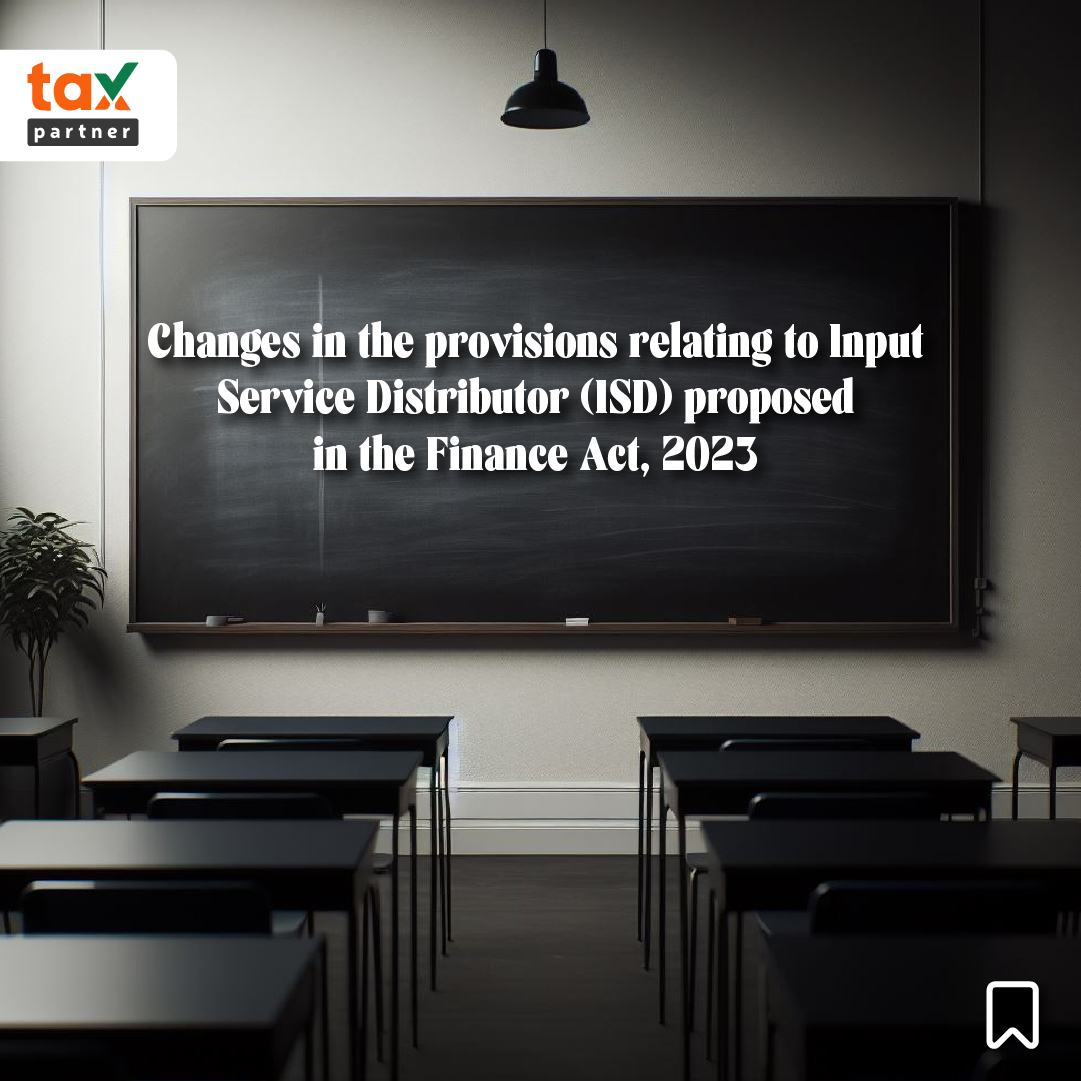Changes in the provisions relating to Input Service Distributor (ISD) proposed in the Finance Act, 2023.
Changes in the provisions relating to Input Service Distributor (ISD) proposed in the Finance Act, 2023.
Author- Tanvi Thapliyal
Following tradition, the Union Government has not introduced substantial changes under indirect tax legislation in its interim budget that came out this year. But the Goods and Services Tax (GST) rules have changed, and the 2023 Finance Act will reflect those changes. Among the most important revisions, one deals with input service distributors and includes new definitional requirements and stricter compliance standards. Input service distribution is the intended focus of this article, which aims to investigate the implications of the 50th GST council meeting, the 2023 interim budget, and the Finance Act 2023 in depth.
Financial Act 2023
The Finance Act of 2023 introduces significant amendments to the provisions governing Input Service Distributor (ISD) under the Goods and Services Tax (GST) framework. The proposed changes aim to streamline and enhance the functioning of ISDs, which play a crucial role in the distribution of input tax credits (ITC) within organisations. These amendments reflect the government's ongoing efforts to strengthen the GST system, improve compliance measures, and facilitate smoother operations for taxpayers. In this introduction, we will delve into the key proposed changes in the ISD provisions outlined in the Finance Act of 2023 and their potential impact on businesses and the broader GST ecosystem.
Who Is An ISD
An Input Service Distributor (ISD) is an entity under the Goods and Services Tax (GST) framework in India that receives invoices for input services and distributes the input tax credit (ITC) to its various branches or units. ISDs typically operate within a multi-location business structure where centralized procurement of services occurs. The primary function of an ISD is to facilitate the proper utilization of input tax credits across different units or divisions of a business entity.
The concept of Input Service Distributor (ISD) is defined under Section 2(61) of the Central Goods and Services Tax (CGST) Act, 2017. This section defines an ISD as follows:
"Input Service Distributor" means an office of the supplier of goods or services or both which receives tax invoices issued under section 31 towards the receipt of input services and issues a prescribed document for the purposes of distributing the credit of central tax, State tax, integrated tax or Union territory tax paid on the said services to a supplier of taxable goods or services or both having same Permanent Account Number as that of the said office."
Let us understand this with the help of an example
-
ABC Corporation is a large manufacturing company with multiple branches located across different states in India.
-
The headquarters of ABC Corporation, located in Delhi, is responsible for centralized procurement of various input services such as legal consultancy, accounting services, and marketing services, which are utilised by its various branches.
-
Now, suppose ABC Corporation receives tax invoices for these input services at its headquarters in Delhi.
-
As per GST regulations, the headquarters of ABC Corporation qualifies as an Input Service Distributor (ISD).
-
It can distribute the input tax credits (ITC) availed on these input services to its branches located in different states.
-
So, the headquarters of ABC Corporation acts as an ISD, receiving tax invoices for input services and distributing the corresponding input tax credits to its branches.
-
This enables effective utilization of ITC across the organization, ensuring compliance with GST regulations and optimizing tax efficiency.
50th GST Council Meeting
During the 50th Meeting, the GST Council acknowledged the report of the law committee, which highlighted that the current practice does not mandate the use of the Input Service Distributor (ISD) mechanism. Currently, a company's head office can procure services from a third party, partly for itself and partly for its branch office, or entirely for the branch office's consumption, and pass on the input GST credit through the issuance of a tax invoice to its branch office using the cross charge route.
In line with this observation, the Central Board of Indirect Taxes and Customs, through Circular No. 199/2023-GST dated 17 July 2023, clarified that the ISD mechanism is not mandatory. However, the Law Committee recommended to the GST Council that, moving forward, the ISD mechanism should be made compulsory. Additionally, input services received from third parties and subject to tax under the reverse charge mechanism should also fall under the purview of the ISD.
The proposals put forth by the Law Committee were duly accepted by the GST Council, indicating a shift towards making the ISD mechanism mandatory for businesses.
Changes Proposed By The Financial Act 2023
1.Changes in the definition of ISD under section 2(61)
Earlier definition-
"Input Service Distributor" means an office of the supplier of goods or services or both which receives tax invoices issued under section 31 towards the receipt of input services and issues a prescribed document for the purposes of distributing the credit of central tax, State tax, integrated tax or Union territory tax paid on the said services to a supplier of taxable goods or services or both having the same Permanent Account Number as that of the said office;
New definition-
"Input Service Distributor" means an office of the supplier of goods or services or both which receives tax invoices towards the receipt of input services, including invoices in respect of services liable to tax under sub-section (3) or sub-section (4) of section 9, for or on behalf of distinct persons referred to in section 25, and liable to distribute the input tax credit in respect of such invoices in the manner provided in section 20.
Note-
Section 9(3) – RCM for registered suppliers & 9(4) RCM for unregistered persons;
Section 25 – Pan-India registration with the same PAN number – called distinct persons.
Section 20 – Defines the procedure for ISD
2.Services under Reverse Charge Mechanism (RCM):
Under the Reverse Charge Mechanism (RCM), the recipient of the services is liable to pay the tax instead of the service provider. This typically applies to services received from specific categories such as security services provided by a proprietorship security company, legal services provided by advocates, and transport services, among others.
The proposed changes suggest including services received under the Reverse Charge Mechanism (RCM) within the purview of the Input Service Distributor (ISD) method. Previously, these services were typically dealt with using the Cross Charge method instead of the ISD method.
The Cross Charge method involves directly charging the cost of services received to the respective cost centers or branches within the organization. In contrast, the ISD method entails centralizing the distribution of input tax credits (ITC) by a designated office (ISD) to various branches or units of the same organization.
The explanation highlights the relevance of the newly substituted Section 20 of the ISD provisions. This section outlines the manner in which the input tax credit (ITC) is to be distributed by the ISD, including the distribution of ITC for services received under the Reverse Charge Mechanism (RCM).
In summary, the proposed changes aim to streamline the distribution of input tax credits (ITC) for services received under the Reverse Charge Mechanism (RCM) by incorporating them into the Input Service Distributor (ISD) method. This ensures consistency and efficiency in the utilization of ITC within organizations, as governed by the provisions outlined in Section 20 of the ISD framework.
3.Changes in section 20
Old Section 20:
The old Section 20 outlined the manner in which an Input Service Distributor (ISD) should distribute the credit of central tax and integrated tax. It specified conditions such as documentation requirements, limits on credit distribution, and the pro rata distribution of credit among recipients based on turnover.
New Section 20:
-
The proposed substitution introduces significant changes to the ISD framework. It mandates any office of the supplier of goods or services receiving tax invoices for input services, including those under the Reverse Charge Mechanism (RCM), to be registered as an ISD and distribute input tax credit accordingly.
-
The ISD is required to distribute the credit of central tax or integrated tax charged on invoices received, including credit for services subject to tax under specific sections of the GST Act, in accordance with prescribed rules.
-
The credit distribution is to be documented and issued in a manner prescribed by the rules.
Salient Features of Changes Proposed:
-
The changes apply prospectively.
-
Services under the Reverse Charge Mechanism are now covered.
-
Registration as an ISD is mandatory if services are obtained for or on behalf of distinct persons referred to in Section 25.
-
Tax credits collected under the new ISD registration number or current ISD number will be distributed accordingly.
-
State tax credits will be distributed as per the respective state's tax when invoices are received locally by the ISD unit.
Differences Between The Earlier And New Provisions-
|
s.no.
|
Particulars
|
Earlier provision
|
New provision
|
impact
|
-
|
Definition covered invoices issue under RCM
|
no
|
yes
|
ISD can now receive the service invoices issued under RCM
|
-
|
Provision of receiving service on behalf of distinct person
|
no
|
yes
|
Definition altered to state that ISD receives service on behalf of distinct person
|
-
|
ISD compliance was compulsory
|
No
|
Yes
|
Section 20(2) amended to replace the word "may" with "shall". Hence making ITC distribution a mandatory compliance
|
-
|
Manner of distribution as per section 20
|
Available
|
To be prescribed
|
The provisions relating to ISD credit distribution shall be prescribed in GST rules.
|
Example to understand the new amendment
-
There is a company named "Softech Innovations," with its headquarters in Mumbai and branch offices in Delhi and Bangalore.
-
Softech Innovations offers IT consulting services throughout India.
-
The company's headquarters frequently acquire services that benefit all branches, like software licences and centralised marketing services.
Prior to the Finance Act of 2023,
-
Softech Innovations had the option to either distribute input tax credits (ITC) through the Input Service Distributor (ISD) mechanism or directly charge the costs (cross charge) to its branches depending on their usage.
-
Imagine if they paid GST on a marketing service that benefits all branches. The main office could generate a tax invoice for its branches to cover their portion of the expenses, which includes GST, using the cross charge approach.
-
Every branch then asserted ITC using the invoice received from the headquarters.
Following the Finance Act of 2023,
-
The ISD mechanism is now required for services such as these.
-
Softech Innovations should ensure its headquarters is registered as an ISD if it hasn't done so yet.
-
Now, once Softech Innovations main office gets an invoice for the marketing service, it needs to allocate the Input Tax Credit to its branches using the Input Service Distributor mechanism.
-
This adjustment guarantees that the ITC distribution is more methodical and aligns with the updated guidelines.
Challenges associated with the new amendment
-
Adjusting to New Regulations:Companies might face difficulties in understanding the details of the updated regulations and modifying their procedures accordingly.
-
Amendments may introducemore compliance requirements for businesses, resulting in a higher administrative burden and the necessity for improved monitoring and reporting.
-
Resource Allocation: Implementing the changes may necessitate businesses to allocate extra resources, such as time, manpower, and financial investments, to guarantee compliance.
-
Implementation Complexity:The amendments' complexity may present challenges when introducing new systems or procedures for distributing input tax credit, particularly for larger organisations with multiple branches or units.
-
Training and Education: Companies might consider investing in training and education initiatives to acquaint their employees with the latest regulations and guarantee successful implementation.
-
Integration with Existing Systems:Incorporating the new requirements into current accounting and reporting systems may pose technical obstacles and necessitate system upgrades or adjustments.
-
Non-compliance risk: Not following the updated regulations may lead to penalties, fines, and legal consequences, emphasising the need for thorough compliance measures.
-
Impact on Business Operations:Alterations in input tax credit distribution mechanisms could potentially disrupt current business operations, resulting in strategic planning and coordination to minimise any adverse effects.
-
Potential for Disruption in Supply Chain: Any interruptions or delays in implementing the changes may affect the seamless operation of the supply chain, impacting business relationships and customer satisfaction.
-
Keeping track of and enforcing the updated regulations may need constant monitoring and enforcement actions, which can be difficult to sustain in the long run.
Benefits associated with the new amendment
-
Enhanced Efficiency: Simplified processes and more defined guidelines for distributing input tax credit can boost efficiency in business operations, minimising administrative hassles and saving time.
-
Improved Transparency:Having clearer rules and regulations can boost transparency in the distribution of input tax credit, which can help minimise errors, disputes, and misunderstandings.
-
Cost Savings: Maximising input tax credits efficiently can lead to cost savings for businesses by taking full advantage of the benefits provided by the GST framework.
-
Standardisation:Implementing standardised procedures for input tax credit distribution can help maintain consistency across various branches or units of a business, guaranteeing uniformity in compliance practices.
-
Legal Clarity: Enhanced guidelines in the Finance Act can provide a clearer legal framework, minimising confusion and helping businesses grasp their compliance responsibilities more effectively.
-
Efficient Resource Allocation: By making the most of input tax credits, businesses can better distribute funds to their main activities.
-
Competitive Advantage: Streamlining input tax credit management can boost businesses' competitiveness through cost reduction and enhanced financial performance.
-
Guiding Decision Making: Well-defined rules and regulations can guide decision-making processes within businesses, empowering them to make strategic choices confidently.
-
Ensuring compliance with the updated regulations can give businesses confidence in following GST laws, minimising the chances of facing penalties or legal consequences.
-
Operational Streamlining: Implementing streamlined processes for input tax credit distribution can enhance operational efficiencies, enabling businesses to concentrate on core activities and strategic initiatives.
Conclusion
The changes made in the Finance Act of 2023 concerning Input Service Distributors (ISD) represent a significant change in how input tax credits are managed and distributed within the GST framework. The modifications are intended to simplify the process, guarantee a more accurate distribution of credits, and broaden the range to cover services under the reverse charge mechanism. For companies, particularly those with operations in multiple states or intricate supply chains, these changes require a review of their existing tax credit distribution methods and could present a chance to enhance tax credit utilisation more efficiently.
Handling these changes may pose a challenge due to the technical aspects and the requirement to meet compliance deadlines. Partnering with a tax advisor who is knowledgeable, such as TaxPartner, can be extremely valuable.
FAQ’s
What is an Input Service Distributor (ISD) under GST?
An Input Service Distributor (ISD) is a business entity that receives invoices for services used by its branches or units across different locations or states. It distributes the GST credit on these services to qualifying branches in a systematic manner.
What changes have been introduced to ISD provisions in the Finance Act of 2023?
The Finance Act of 2023 introduces changes to enhance the clarity, efficiency, and scope of input tax credit distribution by ISDs. These changes include clearer definitions, mandatory registration requirements, and the inclusion of services under the reverse charge mechanism.
How will the new changes affect the distribution of input tax credits?
The new changes are designed to streamline the process of distributing input tax credits, ensuring that credits are distributed accurately and efficiently among branches or units of a business, including those for services charged under the reverse charge mechanism.
Is registration as an ISD now mandatory for all businesses?
Yes, under the new provisions, any office of a supplier that receives tax invoices for input services for itself or its branches must register as an ISD if it intends to distribute the input tax credit.
Can input tax credits for services under the reverse charge mechanism be distributed by ISDs?
Yes, the new provisions explicitly include services liable to tax under the reverse charge mechanism within the ambit of input tax credit distribution by ISDs.
What documentation is required for distributing input tax credits as an ISD?
ISDs must issue a document containing the amount of input tax credit being distributed. The specific requirements and format for this document will be prescribed by the GST regulations.
Are there any restrictions on how input tax credits can be distributed to branches or units?
Yes, the distribution of input tax credits must not exceed the available credit, and credits must be distributed only to those units or branches to which the services are attributable, in proportion to their respective turnovers.
How will the changes impact businesses with operations in multiple states?
Businesses with operations across multiple states may need to ensure that their ISD registrations and input tax credit distribution practices comply with the new provisions, potentially leading to more streamlined and efficient cross-state credit utilization.
What should businesses do to comply with the new ISD provisions?
Businesses should review their current input tax credit management practices, ensure they have the necessary ISD registrations, and adjust their processes to meet the new requirements for documentation and distribution of credits.
Where can businesses find more information about complying with the new ISD provisions?
Businesses can refer to the official GST portal, consult the Finance Act of 2023, or seek advice from tax professionals to understand the new requirements and ensure compliance.



